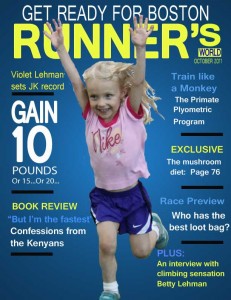Below are a number of exercises that are typically called stability exercises. While this might be true they are really movements to me. These movements can make you stronger, can calm down your pissed off nervous system and can increase your capacity to withstand stress. We typically say that they increase your stability but I think it is more complicated. They are many reasons to do these exercises and if you are unsure please ask. The body is smarter than we are. If our spine could talk I bet it would be pretty condescending discussing how we try to explain its function.
thebodymechanic.ca
Runner Strength: Basic Exercise Videos for runners
Audience: Patients
Purpose: Exercise videos for patients wishing to train their trunk and hips
This article is just a video series for runners to do some basic strength work. Stop worrying about the core. Just get strong during all movements. We try to build capacity to withstand load. We might also improve running efficiency with strength work. There could probably be thirty different exercises below. This is not a program just a few suggestions for what can be easily done. You will notice that there are no exercises that are specifically “core” exercises. I am of the opinion that this is over rated for running and that any benefits to training the core can be gleaned from the appropriate choice of compound exercises. (more…)
Running Injury Prevention: A brief review of what we know…and more of what we don’t
Audience: Runners and Therapists
Purpose: A quick guide to running injury prevention.
Preamble
Injury prevention for runners is not rock-solidly founded in science… and may not even be possible. With runners it is more injury management. You are going to get injured and you are going to have some aches and pains. The ideal is to minimize your lost training time and avoid some of the nasty injuries that can jeopardize your long term running and goals. (more…)
Stop foam rolling your IT Band. It can not lengthen and it is NOT tight.
Audience: Patients and therapists
Purpose: A brief argument on why attempting to lengthen your IT Band with stretching or foam rolling is a waste of time and not possible.
I am in the minority when I cringe at the rampant unjustified use of the ubiquitous, seemingly harmless but actually evil foam roller for IT Bands. I’ve seen their use climb in the past 5 years and I am sure that my success rate at convincing my patients to not roll the crap out of their IT Bands is less than 10%. Those rollers are WINNING. Perhaps this post will sway the voters. (more…)
Stretching Muscle: A brief summary on what it does.
Rapid Fire Overview
Most of the ideas are from the work of Magnusson. I have been preaching this research for 15 years and was basically motivated because of self intentions. My flexibility is poor and I never thought that stretching the spine made any sense for low back pain prevention. I went out looking for some support and Magusson (1996) was the king in this area. A recent review is here (its free) He also has great research questioning the utility of eccentric loading protocols for tendinopathy as he prefers heavy resistance training (click here). I have a quick post here inspired by his work related to high hamstring tendon pain.
Why do people feel stiff? Are your muscles really tight?
This article is purely conjecture. I have no hard data and would not even know how to create a study to test for it. BUT, I consider it biological plausible.
Tightness is a common sensation for people with pain and for athletes during training. However, when someone reports being tight in a region I find that they rarely are. Their range of motion will be wonderful, perceptually their tissue will feel “loose” upon palpation (warning: highly subjective on my part) yet they report tightness. Main point being there are no objective signs of tightness or limits in their range of motion. So why does the perception of tightness occur? (more…)
Basic Shoulder Movement Videos
Audience: Patients
Purpose: Exercise videos for those doing shoulder rehabilitation
Preamble
The same exercises or movements can be used with different intentions and to achieve a different goal. Some possible intentions being:
1. Motion is Lotion - we are moving your shoulder in a manner just to calm down nerves, decrease pain and get that pissed off shoulder happy with moving again. The amount of weight or resistance is not that important
2. Stress loading - for whatever reason we want to stress your shoulder and shoulder girdle musculature. You might have some weakness (e.g. prolonged immobility, post surgical) or we wish to increase the capacity of your joint and muscles to withstand load. Appropriate weight selection, speed of movement and technique is important
3. Motor control - certainly there is some overlap with the previous two intentions mentioned. But with this intention we might look at trying to change how your muscles work together. An example, is training both the internal and external rotator cuff during alternating movements. We are trying to get the cuff to pull the humeral head away from the scapula or just get the muscles happy working together again. Load or stress is important but so is learning the movement.
Running mechanics video - great for comparison with your form
 Audience: Runners and therapists
Audience: Runners and therapists
Purpose: A reference to compare running technique
Limitations: Many of us assume that there is one right and better way to run. Deviations from that ideal are assumed to lead to injuries and decreased economy. This is still a debatable concept. Everything I write can be questioned so please do so.
Below is a video of Nicole Stevenson (www.nicolestevenson.com). Nicole is Canada’s former number 1 in the Marathon with a personal best below 2:33. Nicole is also a running coach
I wanted to highlight some probably beneficial components of her running gait. Future posts will look a deviations from this gait and how they might relate to injury. (more…)
Persistent Pain Resources for Patients
Audience: Patients
Purpose: to provide some information about the pain experience
Why?: Understanding pain can help modify it
I don’t pretend to understand everything about pain. It is incredible complex and what we know is certainly involving. However, there is a lot of misinformation out there even from people that should know better. This article will link to a number of information sites that help explain pain. This is important because it helps you understand why things hurt. Understanding why something hurts can decrease pain but can also help you function better. Some basic concepts:
1. Pain is a perception. Signals (e.g. nociception or even pressure) come from the body and the brain creates an output that we perceive as pain. Ever heard of a soldier being shot and not feeling any pain until they were safe and out of harms way? If pain was some absolute thing that the brain has no choice to recognize than you would have no way but to feel pain any time a tissue was injured. We’ve all heard stories of people being injured but feeling nothing.
2. Your body does not have to be injured to feel pain. In fact you can lose a limb and later feel pain in that limb that no longer exists.
3. Tissue injuries (e.g. disc bulges, rotator cuff tears, tendinopathy) do not have to hurt. The body can have lots of so called “dysfunction” but this does not mean that you will feel pain. For example, 50% of people over fifty may have a rotator cuff tear but they experience no pain.
4. Emotions, beliefs, stress, past experiences etc can influence the pain that you feel. Pain is more than a punch in the arm.
5. The perception of pain can move around in your body and this does not mean that you are crazy. This is a normal finding when we experience persistent pain.
6. Pain changes how we move and how we function. Movement is often the key to resolving pain.
There is so much more than this but I will let the resources below provide better information.
Books
1. The sensitive nervous system (D Butler): a great academic reference
2. Explain Pain (Butler and Moseley): a patient’s guide to pain
3. Painful Yarns: stories from people with pain
Websites
1. Neurotopian: Pain for Dummies a great site, you can read this an ignore everything I say.
Youtube
1. Persistent pain described with pictures
2. Lorimer Moseley: Tedx Talks
All the best,
Greg



